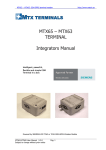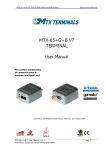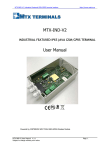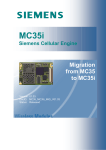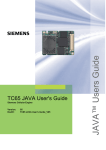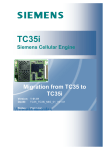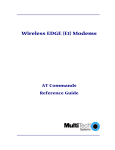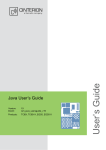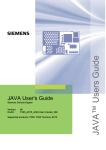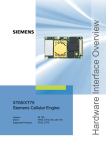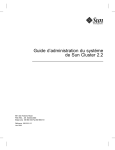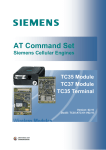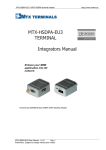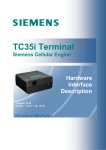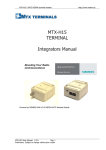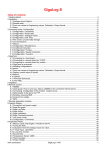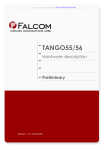Download MIX MODEM GSM TERMINAL Integrators Manual
Transcript
MIX Modem - GSM MIX MODEM GSM TERMINAL Integrators Manual Intelligent, powerful, flexible and simple GSM Terminal in a box Powered by CINTERION (Osaka Solutions) WM Modem TC or GSM65 GSM-GPRS Wireless Module User Manual V.1.1 Subject to change without prior notice Pag. 1 MIX Modem - GSM 1. INTRODUCTION 4 1.1 Description ....................................................................................................................... 4 1.2. ORDERING INFORMATION ................................................................................................ 4 Hardware revision: 1.01 .......................................................................................................... 4 Firmware revision: .................................................................................................................. 4 MTX-63I: 01.100 .................................................................................................................... 4 MTX-65I: 01.1001.2 Highlights ................................................................................................. 4 1.2 Highlights ......................................................................................................................... 5 1.3 MTX-63I/65I Wireless modems in a Communication System................................................... 7 1.4 Main Features and Services ................................................................................................ 7 1.4.1 Types of Mobile Station ........................................................................................................................... 7 1.4.2 Short Message Service ............................................................................................................................. 8 1.4.3 Voice Calls .............................................................................................................................................. 8 1.4.4 Data ......................................................................................................................................................... 8 1.4.5 GPRS Multi-Slot Support......................................................................................................................... 9 1.4.6 Power Consumption ................................................................................................................................ 9 1.4.7 SIM Card ............................................................................................................................................... 11 1.5 Precautions .................................................................................................................... 11 2. MECHANICAL DESCRIPTION ................................................................................................................... 11 2.1 Overview ....................................................................................................................... 11 2.2. Dimensions ................................................................................................................... 12 3. ELECTRICAL DESCRIPTION ..................................................................................................................... 13 3.1 Power Connector ............................................................................................................ 13 3.2 Audio Connector ............................................................................................................. 15 3.3 Mini USB Connector ......................................................................................................... 18 3.4 Antenna Connector ......................................................................................................... 19 3.5. SIM card reader ............................................................................................................. 19 3.6 MAIN Serial RS232 Interface Port ASC0 .......................................................................... 19 3.7 Expansion I/O port .......................................................................................................... 21 3.7.1. SECONDARY SERIAL RS232 INTERFACE ASC1 .............................................................................. 23 3.7.2. I2C Serial Control Bus ......................................................................................................................... 23 3.7.3. SPI Bus ONLY MTX-65I ....................................................................................................................... 24 3.7.4. General Purpose IO (ONLY MTX-65 V3) ............................................................................................ 25 3.7.5. Analog-to-Digital Converter (ADC ...................................................................................................... 26 3.7.6 Real Time Clock .................................................................................................................................... 27 3.8. Software Updates........................................................................................................... 28 4. OPERATION .................................................................................................................................................... 29 4.1 Switching On the Modem ................................................................................................. 29 4.2 Switching Off the Modem ................................................................................................. 29 4.3 Operating States/LED ...................................................................................................... 29 5. EMBEDDED APPLICATIONS. ONLY MTX-65I ....................................................................................... 31 6 SAFETY AND PRODUCT CARE ................................................................................................................... 32 6.1. 6.2. 6.3. 6.4. 6.5. 6.6. Safety instructions.......................................................................................................... 32 General precautions ....................................................................................................... 32 SIM card precautions ...................................................................................................... 32 Antenna precautions....................................................................................................... 33 Radio Frequency (RF) exposure and SAR .......................................................................... 33 Personal Medical Devices ................................................................................................ 33 7. INSTALLATION OF THE MODEM ............................................................................................................ 34 7.1 Where to install the modem ............................................................................................. 34 7.1.1 Environmental conditions ...................................................................................................................... 34 7.1.2 Signal strength ....................................................................................................................................... 34 7.1.3 Connections of components to MTX-63I/65I Terminal ......................................................................... 34 7.1.4 Network and Subscription ..................................................................................................................... 34 User Manual V.1.1 Subject to change without prior notice Pag. 2 MIX Modem - GSM 7.2 How to install the modem ................................................................................................ 34 7.2.1 Power supply ......................................................................................................................................... 34 7.2.2 Securing the modem .............................................................................................................................. 35 7.3 Antenna ......................................................................................................................... 35 7.3.1 General .................................................................................................................................................. 35 7.3.2 Antenna type .......................................................................................................................................... 35 7.3.3 Antenna placement ................................................................................................................................ 35 7.3.4 The antenna cable.................................................................................................................................. 35 7.3.5 Possible communications disturbances ................................................................................................. 36 8. ACCESSORIES ................................................................................................................................................ 37 1. POWER SUPPLY ................................................................................................................ 37 1.1 AC Power Adaptor ................................................................................................................................... 37 1.2 DC cable ................................................................................................................................................... 37 2. ANTENNAS ....................................................................................................................... 38 2.1 Magnetic Dual Band Antenna (900/1800MHz) ........................................................................................ 38 2.2 Right angle short antenna......................................................................................................................... 38 2.3 Patch Adhesive Antenna ........................................................................................................................... 38 3. CABLES ........................................................................................................................... 39 3.1 SERIAL CABLE ........................................................................................................................................ 39 3.2 USB CABLE ............................................................................................................................................. 39 3.3 Expansion port - RS232 2-way Serial Cable ........................................................................................... 39 4. DEVELOPMENT KITs ......................................................................................................... 40 9, CONFORMITY ASSESSMENT...................................................... ¡ERROR! MARCADOR NO DEFINIDO. FCC COMPLIANT AND SAR INFORMATION ............................................................................................. 41 10. ROHS STATEMENT ..................................................................................................................................... 42 11. DISPOSAL OF OLD ELECTRICAL & ELECTRONIC EQUIPMENT (WEEE MARK) .................... 42 12. ABBREVIATIONS......................................................................................................................................... 43 13. AT COMMAND SUMMARY ....................................................................................................................... 44 15. SALES CONTACT ......................................................................... ¡ERROR! MARCADOR NO DEFINIDO. User Manual V.1.1 Subject to change without prior notice Pag. 3 MIX Modem - GSM 1. INTRODUCTION 1.1 Description The MTX-63I/65I is an intelligent GSM/GPRS control terminal that encapsulates everything you need for wireless M2M capability in one compact unit. The MIX MODEM GSM in conjunction with JAVA SDK software package can host and control your wireless application, minimizing the need for extra components. Alternatively, it can be used as a powerful standalone GPRS modem with its intrinsic TCP/IP stack. The MTX-63I/65I is a self contained terminal with its own SIM card reader and 3 standard connectors interfaces, minimizing the need for further hardware development. This terminal can be used as a powerful and flexible device that can be used in a wide range of telemetry and telematics applications that rely on the remote exchange of data, voice, SMS or faxes via the GSM cellular network. As well as providing a standard RS232 serial communication interface the MTX-63I/65I also has an audio interface allowing an analogue handset to be connected. Also a USB port is included to allow the connectivity to all relevant PCs and control boards in office and industrial environments. The MIX MODEM GSM in their expansion port has a wide and useful range of IOs that can be reconfigured to add functions and features that make your M2M solution both innovative and cost effective. The MTX-63I/65I can be used to provide a communications link for a variety of wireless applications including fleet and asset management, vending, security and alarm monitoring, e-maintenance and other telemetry applications. With quad band 900/1800 MHz and 850/1900 MHz, your applications can be used all over the world. The MIX MODEM GSM incorporates a Cinterion WM MODEM TC module and the MIX MODEM GSM has a TC65I inside. Note! Some of the functions described inside this Technical Description are only possible when the SIM-Card is inserted 1.2. ORDERING INFORMATION MTX-65I: 199801116 MTX-63I: 199801115 Hardware revision: 1.01 Firmware revision: MTX-63I: 01.100 MTX-65I: 01.100 User Manual V.1.1 Subject to change without prior notice Pag. 4 MIX Modem - GSM 1.3 Highlights Interfaces • FME M 50 Ohm antenna connector • Expansion Port: 15-way HD-Dsub: Only for MTX-65I 4 Digital Input/Output 2 Analog Input 1 x I2C/SPI bus 1 x 2-wires RS232 UART • RS232 - 9 pin D-sub connector for serial interfaces (ITU-T V.24 protocol) • USB mini (2.0 Full-Speed End-Point Compliant) • Operating status LED • SIM card interface 3 V, 1.8 V with SIM detection • Plug-in power supply and on/off interfaces • Handset audio interface • VRTC + Alarm General Features • • • • • • • • • • • • • Quad-Band GSM 850/900/1800/1900 MHz GPRS multi-slot class 12 GSM release 99 Output power: - Class 4 (2 W) for EGSM850 & EGSM900 - Class 1 (1 W) for GSM1800 & GSM1900 Control via AT commands (Hayes 3GPP TS 27.007 and 27.005) SIM Application Toolkit (release 99) TCP/IP stack access via AT commands Internet Services: TCP, UDP, HTTP, FTP, SMTP, POP3 Supply voltage range: 6 ... 30 V Power consumption (at 12 V): - Power down 0,5 mA - Sleep mode (registered DRX = 5) 29 mA - Speech mode (average) 184 mA - GPRS class 12 [Power reduction = 6dB] (average) 330 mA Temperature range - Operation: -30°C to +70°C - Storage: -40°C to +85°C Dimensions. Excluding connectors:78,1 x 66,8 x 37,2 mm Weight: < 190 g GPRS data transmission • • • • GPRS class 12 Mobile station class B PBCCH support Coding schemes CS 1-4 Multiple simultaneous PDP contexts User Manual V.1.1 Subject to change without prior notice Pag. 5 MIX Modem - GSM CSD data transmission • • • • Up to 14.4 kbit/s V.110 Non-transparent mode USSD support Specification for fax • Group 3, class 1, 2 Voice Features • • • • • Triple-rate codec for HR, FR, and EFR Adaptive multi-rate AMR Basic hands-free operation Echo cancellation Noise reduction Short Message Service (SMS) Features • Point-to-point MO and MT • SMS cell broadcast • Text and PDU mode Internet Protocols TCP/UDP/IP protocol stack Extensive AT command access to TCP/IP stack Internet Services: TCP, UDP, HTTP, FTP, SMTP, POP3 Open application resources (only MTX-65I) ARM© Core, Blackfin© DSP • Memory: 400 KB (RAM) and1.7 MB (Flash) • Improved power-saving modes Java™ features (only MTX-65I): • CLDC 1.1 Hl • J2ME™ profile IMP-NG • Secure data transmission with HTTPS, SSL and PKI Over-the-air update (only MTX-65I) • Application SW: OTAP • Firmware: FOTA (OMA compliant) User Manual V.1.1 Subject to change without prior notice Pag. 6 MIX Modem - GSM 1.4 MTX-63I/65I Wireless modems in a Communication System Figure 1 and Figure 2 illustrate the main blocks of a wireless communication system using the wireless modem. Figure 1 show the communication system when a micro-controller is used. They also show the communication principles of the system and the interface between the wireless modem and the application and Figure 2 shows the communication system when the JAVA application is embedded on the wireless modem. The definitions in the figures, as used elsewhere in this manual, are in accordance with the recommendations of 3GPP TS 27.007. The MS (mobile station) represents the wireless modem and SIM card. The wireless modem excluding SIM card, is known as the ME (mobile equipment). The DTE (data terminal equipment) is the controlling application. This can be either an external host or an internal embedded application. The DCE (data circuit terminating equipment) is the serial communication interface of the MS. Figure 1. Main Blocks in a Wireless System (external micro-controller) Figure 2. Main Blocks in a Wireless System (embedded application) 1.5 Main Features and Services The MTX-63I/65I performs a set of telecom services (TS) according to GSM standard phase 2+, ETSI and ITU-T. The services and functions of the MTX-63I/65I are implemented by issuing customized applications embedded on the device, or by AT commands issued internally, or over the RS232 serial interface. 1.5.1 Types of Mobile Station The MTX-63I/65I is a fully Quad Band capable GSM/GPRS mobile station with the characteristics shown in the table below. User Manual V.1.1 Subject to change without prior notice Pag. 7 MIX Modem - GSM Feature GSM850 E-GSM900 GSM1800 GSM1900 824-849 880-915 1710-1785 1850-1910 Rx 869-894 RF power @ARP with 33dBm 50Ω load (typ) Channel spacing 200kHz 925-960 1805-1880 1930-1990 33dBm 30dBm 30dBm 200kHz 200kHz 200kHz Number of channels 124 174 374 299 Number of TD slots 8 8 8 8 Duplex spacing 45MHz 45MHz 95MHz 80MHz GSM power class 4 (2W) 4 (2W) 1 (1W) 1 (1W) Modulation GMSK Receive sensitivity <-102dBm at antenna connector GPRS multi-slot class Class 12 Frequency range (MHz) Tx 1.5.2 Short Message Service The wireless modem supports the following SMS services: • Sending; MO (mobile-originated) with both PDU (protocol data unit) and text mode supported • Receiving; MT (mobile-terminated) with both PDU and text mode supported • CBM (cell broadcast message); a service in which a message is sent to all subscribers located in one or more specific cells in the GSM network (for example, traffic reports) • SMS status report according to 3GPP TS 23.40 The maximum length of a text mode SMS message is 160 characters using 7-bit encoding. The wireless modem supports up to six concatenated messages to extend this function. Concatenation is performed by the host application. 1.5.3 Voice Calls The wireless modem offers the capability of MO (mobile originated) and MT (mobile terminated) voice calls, as well as supporting emergency calls. Multi-party, call waiting and call divert features are available. Some of these features are network operator specific. For the inter-connection of audio, the wireless modem offers balanced analogue input and output lines. The wireless modems support HR, FR, EFR and AMR vocoders. 1.5.4 Data The wireless modem supports the following data protocols: • GPRS (General Packet Radio Service) The wireless modem is a Class B terminal. The wireless modem is GPRS multi-slot class10 (4+2) enabled, capable of receiving at a maximum of four timeslots per frame (down link), and transmitting in two timeslots per frame (up link). See section 1.4.5 for multi-slot allocation by class. • CSD (Circuit Switched Data) The MTX-63I/65I wireless modem is capable of establishing a CSD communication at 9.6 kbps and 14,4 kbps over the air. User Manual V.1.1 Subject to change without prior notice Pag. 8 MIX Modem - GSM 1.5.5 GPRS Multi-Slot Support GSM Multi-slot classes supported by MTX-63I/65I Multislot Class Maximum slot allocation Downlink Uplink Active Allowable Configuration 8 4 5 1 up; 4 down Max data rate 8-12Kbps Send 1 32-48Kbps Receive 8-12Kbps Send 1 up; 4 down 32-48Kbps Receive 10 4 2 5 16-24Kbps Send 2 up; 3 down 24-36Kbps Receive 12 4 4 5 1 up 4 down 2 up 3 down 3 up 2 down 4 up 1 down 8-12kpbs per slot 1.5.6 Power Consumption The table below briefly summarizes the various operating modes referred to in the following chapters. GSM / GPRS SLEEP Various power save modes set with AT+CFUN command. Software is active to minimum extent. If the Terminal was registered to the GSM network in IDLE mode, it is registered and paging with the BTS in SLEEP mode, too. Power saving can be chosen at different levels: The NON-CYCLIC SLEEP mode (AT+CFUN=0) disables the AT interface. The CYCLIC SLEEP modes AT+CFUN=7 and 9 alternately activate and deactivate the AT interfaces to allow permanent access to all AT commands. GSM IDLE Software is active. Once registered to the GSM network paging with BTS is carried out. The Terminal is ready to send and receive. GSM TALK Connection between two subscribers is in progress. Power consumption depends on network coverage individual settings, such as DTX off/on, FR/EFR/HR, hopping sequences, antenna. GPRS IDLE Terminal is ready for GPRS data transfer, but no data is currently sent or received. Power consumption depends on network settings and GPRS configuration (e.g. multislot settings). GPRS DATA GPRS data transfer in progress. Power consumption depends on network settings (e.g. power control level), uplink / downlink data rates, GPRS configuration (e.g. used multislot settings) and reduction of maximum output power. Normal operation POWER DOWN Normal shutdown after sending the AT^SMSO command, after pressing the ON/OFF key or after the activation of the ONOFF line. The RTC works continuously, but the software is not active. Interfaces are not accessible. Airplane mode Airplane mode shuts down the radio part, causes the Terminal to log off from the GSM/GPRS network and disables all AT commands whose execution requires a radio connection. Airplane mode can be controlled by the AT commands AT^SCFG and AT+CALA: With AT^SCFG= MEopMode/Airplane/OnStart the Terminal can be configured to enter the Airplane mode each time when switched on or reset. The parameter AT^SCFG=MEopMode/Airplane can be used to switch back and forth between Normal mode and Airplane mode any time during operation. Setting an alarm time with AT+CALA followed by AT^SMSO wakes the module up into Airplane mode at the scheduled time. User Manual V.1.1 Subject to change without prior notice Pag. 9 MIX Modem - GSM Average power consumption Parameter Description Conditions VPOWER Operating Voltage for one minute Min Typ 6 12 Max Unit 30 V 36 V @8V Power Down mode @12V TBD mA TBD mA TBD mA TBD mA TBD mA TBD mA TBD mA TBD mA @30V @8V SLEEP mode @12V @30V @8V IDLE mode @12V @30V IPOWER Average supply current (average time 3 min.) @25°C @ worst case: GSM 900 max power level @8V TALK mode @12V @30V @8V Data GPRS 1Tx / 4Rx @12V @30V @8V Data GPRS 2Tx / 3Rx (Power reduction = 3dB) @12V @30V @8V Data GPRS 4Tx / 1Rx (Power reduction = 6dB) @12V @30V IPOWER_P (6) Peak supply current during transmission slot (577µs * No. of Tx every 4.6ms) @8V Power control level for Pout max @12V @30V The power consumption figures shown represent typical average current and making different multi-slot configurations, the worst case being that of two uplink and three downlink slots. (6) Typical values measured with antenna impedance = 50 Ohm (return loss >20dB) User Manual V.1.1 Subject to change without prior notice Pag. 10 MIX Modem - GSM 1.4.7 SIM Card The MTX-63I/65I supports an external SIM card through the integrated SIM holder. Both 3V and 1.8V SIM technology is supported. Older, 5V SIM technology is not supported 1.5 Precautions The MTX-63I/65I as a standalone item is designed for indoor use only. To use outdoors it must be integrated into a weatherproof enclosure. Do not exceed the environmental and electrical limits specified. 2. MECHANICAL DESCRIPTION 2.1 Overview The pictures below show the mechanical design of the module along with the positions of the different connectors and mounting holes. The module case is made of durable PC/ABS plastic. Figure 3. MTX-63I/65IModule viewed from the right side Figure 4. MTX-63i/65iModule viewed from the left side User Manual V.1.1 Subject to change without prior notice Pag. 11 MIX Modem - GSM 2.2. Dimensions Figure 5. Dimensions of the MTX-63I/65I terminal in mm User Manual V.1.1 Subject to change without prior notice Pag. 12 MIX Modem - GSM 3. ELECTRICAL DESCRIPTION All electrical connections to the module are protected in compliance with the standard air and contact Electrostatic Discharge (ESD). The module uses the following industry standard connectors: • D-Sub 9 pin female (Main RS232 serial port) • High density 15 pin D-Sub(Secondary RS232 UART and extended I/O interface) • RJ12 6-way (power supply connector) • RJ12 4-way (handset connector) • SIM card reader • FME male coaxial jack (antenna connector) 3.1 Power Connector An RJ12 6-way connector, as shown and described below, serves means of supplying and controlling d.c. power to the modem. The supply voltage, VCC, required by the modem is in the range 6-32V d.c. The power supply has to be a single voltage source capable of providing a peak during an active transmission. The uplink burst causes strong ripples (drop) on the power lines. Application of the supply voltage does switch the modem on. Automatic restart after shutdown: This allow to an application to be always switched on resp. to be able to restart by itself. The terminal will not need external ignition to be powered up. The terminal will be powered up 100% time if power is applied. The only way to shut down the terminal is applying continuously positive signal in pin 3 of J1 RJ11 power connector. The powered up with a RTS Pulse has been removed. An active-high control signal, TURN_OFF, can be used to switch modem off when continuously applied, or can be used to perform hardware reset when applied for > 3.5s. User Manual V.1.1 Subject to change without prior notice Pag. 13 MIX Modem - GSM PIN: Signal Dir Limits Description 6-32 V DC Positive power input 1 VCC Input 2 Not connected - 3 TURN_OFF Input 5 – VCC 4 TURN_ON Input 5 – VCC 5 VDDLP I/O Vmax 4,3 V 6 GND Input Active high control line used to switch off or reset the modem VIH > 5V, VIL < 2V Power off: Continuosly Internally not connected. Terminal will switch on automatically. Backup the RTC from an external capacitor or a battery (rechargeable or non-chargeable). Negative power (ground) Note. VCC and GND are reverse polarity and overvoltage protected. User Manual V.1.1 Subject to change without prior notice Pag. 14 MIX Modem - GSM 3.2 Audio Connector A 6-way 4-poles RJ connector, as shown below, allows a telephone handset to be plugged into the modem, giving access to the microphone and earpiece signals. The connector may also be used to drive other analogue audio sub-systems or devices. The audio interface provides one analog input for a microphone and one analog output for an earpiece. • The microphone input and the earpiece output are balanced. • For electret microphones a supply source is implemented. • The MTX-63I/65I is pre-configured to work with a range of handsets, the audio interface is flexible and its performance can be configured, using AT commands, to match a particular handset or audio subsystem. • Earpiece outputs are short-circuit protected. Audio handset connection. Audio signal descriptions are listed below: Pin Signal Dir Description 0 Not connected 1 MICN I 2 EPN O 3 EPP O 4 MICP I Microphone input Earpiece output Earpiece output Microphone input 5 Not connected User Manual V.1.1 Subject to change without prior notice negative negative positive positive Pag. 15 MIX Modem - GSM The electrical characteristics of the voiceband part vary with the audio mode. Specifications are listed in following table. To suit several types of audio equipment, three audio modes given by default can be selected by the AT command AT^SNFS. The audio mode 1 are optimized for the reference handset (type Votronic) connected to the MTX63I/65I Terminal, and to ensure that the reference parameters are always within the limits demanded by the standards they cannot be changed by AT command. Furthermore, the reference parameters are set as factory default. In audio mode 4 and 5, the gain in the microphone, earpiece and the side tone path can be adjusted from the cellular device application by using further AT commands. Please note that the 2nd audio interface of the MODEM TC/65I module is not connected in the MTX63I/65I Terminal. Audio modes 2, 3 and 6 can be selected by setting AT^SAIC=2,1,1, Mode No AT^SNFS= 1 (Default settings, not adjustable) 4 5 Name Default Handset User Handset Plain Codec 1 Purpose Recommended handset User handset Gains programmable via AT command NO YES YES Sidetone YES YES YES Volume control NO YES YES Echo control (send) Cancellation suppression Noise suppression YES YES NO MIC input signal for 0dBm0 @ 1024 Hz (at default gain settings) 12.5 mV 12.5 mV 400 mV Earpiece output signal in mV eff. @ 0dBm0, 1024 Hz, no load (at default gain settings); @ 3.14 dBm0 475 mV 475 mV (default @ max volume) 1.5 V 6.0 Vpp Sidetone gain (at default settings) 24.9 dB 24.9 dB -∞ dB User Manual V.1.1 Subject to change without prior notice and Cancellation suppression provided and Direct access speech coder NO Pag. 16 to MIX Modem - GSM The electrical characteristics are given in the table below. Function Microphone Signal name MICP, MICN IO Parameter Min. Typ. Max. Unit I DC (no load) at MICP 5.3 5.4 5.6 V DC at MICP in POWER DOWN 0V V DC (no load) at MICN 0 V DC Resistance differential MICN, MICP (balanced) 4.6 4.7 4.8 kOhm Impedance Zi (balanced) 3.9 4.0 4.1 kOhm 0.6 VPP Input level Uimax Restricted Input level Uires 7 Earpiece EPP, EPN O 1.6 Gain range 6 dB steps 0 42 dB Frequency Range 200 3900 Hz fine scaling by DSP (inCalibrate) -∞ 0 dB Impedance (balanced) 8 AC output level UO Gain = 0dB @ 3.14 dBm0 no load Gain range Ohm 5.97 -18 VPP 0 Gain accuracy dB 0.8 dB 3900 Hz DC Offset (balanced) 100 mV Attenuation distortion for 200...3900Hz 1 dB Frequency area Out-of-band discrimination LEAudio VPP Length of Audio (Handset) cable 200 70 dB 3 m Unless otherwise stated, all specified values are valid for gain setting (gs) 0dB and 1kHz test signal. gs = 0dB means audio mode = 5, inBbcGain= 0, inCalibrate = 32767, outBbcGain = 0, OutCalibrate = 16384, sideTone = 0. The electrical characteristics of the voiceband part depend on the current audio mode selected by the AT command AT^SNFS. See Table 9: Audio modes. The audio modes 4 and 5 can be adjusted by parameters. Each audio mode is assigned a separate parameter set. User Manual V.1.1 Subject to change without prior notice Pag. 17 MIX Modem - GSM Audio Parameters Adjustable by AT Commands Parameter Influence to Range Gain range Calculation inBbcGain MICP/MICN analog amplifier gain of baseband controller before ADC digital attenuation of input signal after ADC 0...7 0...42dB 6dB steps 0...32767 -∞...0dB 20 * log (inCalibrate/ 32768) outBbcGain EPP/EPN analog output gain of baseband controller after DAC 0...3 0...-18dB 6dB steps outCalibrate[n] n = 0...4 Digital attenuation of output signal after speech decoder, before summation of sidetone and DAC present for each volume step[n] Digital attenuation of sidetone is corrected internally by outBbcGain to obtain a constant sidetone independently to output volume 0...32767 -∞...+6dB 20 * log (2 * outCalibrate[n]/ 32768) 0...32767 -∞...0dB 20 * (sideTone/ 32768) inCalibrate sideTone log 3.3 Mini USB Connector TC65 supports a USB 2.0 Full Speed (12Mbit/s) device interface. The USB interface is primarily intended for use as command and data interface and for downloading firmware. The USB I/O pins are capable of driving the signal at min 3.0V. They are 5V I/O compliant. The USB port has different functions depending on whether or not Java is running. Under Java, the lines may be used for debugging purposes (see [16] for further detail). If Java is not used, the USB interface is available as a command and data interface and for downloading firmware. The USB I/O-pins are capable of driving the signal at min 3.0V. They are 5V I/O compliant. To properly connect the module’s USB interface to the host a USB 2.0 compatible connector is required. Furthermore, the USB modem driver delivered with MIX MODEM GSM must be installed as described below. The USB host is responsible for supplying, across the VUSB_IN line, power to the module’s USB interface, and all the other MTX-65i interfaces. This is because MTX-65i is designed as a self powered device compliant with the “Universal Serial Bus Specification Revision 2.0” User Manual V.1.1 Subject to change without prior notice Pag. 18 MIX Modem - GSM 3.4 Antenna Connector The antenna connector allows transmission of radio frequency (RF) signals between the modem and an external customer-supplied antenna. The modem is fitted with a 50Ω, FME male coaxial jack. The external antenna must be matched properly to achieve best performance regarding radiated power, DC-power consumption, modulation accuracy and harmonic suppression. 3.5. SIM card reader The MTX-63I/65I Terminal is fitted with a SIM card reader designed for 1.8V and 3V SIM cards. It is the flip-up type which is lockable in the horizontal position and is accessed through a removable panel as shown below. The card holder is a five wire interface according to GSM 11.11. A sixth pin has been added to detect whether or not the SIM card drawer is inserted. Removing and inserting the SIM card during operation requires the software to be reinitialized. Therefore, alter reinserting the SIM card it is necessary to restart MTX65I Terminal. The full operation of the MTX-63I/65I relies on a SIM card being inserted. Some MTX-63I/65I functionality may be lost if you try to operate the control terminal without a SIM card 3.6 MAIN Serial RS232 Interface Port ASC0 The modem supports a standard RS232 serial interface (EIA/TIA 574) via its 9 pin Sub-D connector, shown below. User Manual V.1.1 Subject to change without prior notice Pag. 19 MIX Modem - GSM MTX-63I/65I Terminal is designed for use as a DCE. (data circuit-terminating equipment) based on the conventions for DCE-DTE connections it communicates with the customer application (DTE- data terminating equipment) using the following signals: • Port TxD @ application sends data to TXD of MTX-63I/65I Terminal • Port RxD @ application receives data from RXD of MTX-63I/65I Terminal The RS-232 interface is implemented as a serial asynchronous transmitter and receiver conforming to ITU-T V.24 Interchange Circuits DCE. It is configured for 8 data bits, no parity and 1 stop bit and can be operated at fixed bit rates from 300bps to 460,800bps. Autobauding supports bit rates from 1,2bps to 460,800bps. Hardware handshake using the /RTS and /CTS signals and XON/XOFF software flow control are supported. In addition the modem control signals DTR, DSR, DCD and RING are available. The MODEM control signal RING (Ring Indication) can be used to indicate, to the cellular device application, that a call or Unsolicited Result Code (URC) is received. The electrical characteristics of the serial port signals are shown below: Note: Outputs at 3kOhm load Pin Signal Dir Voltage levels Description 1 DCD O Min ±5V Data carrier detect 2 RD 0 O Min ±5V Received data 3 TD 0 I 4 DTR I 5 GND - 0V Ground connection 6 DSR O Min ±5V Data set ready 7 RTS I VILmax = 0.6V VIHmin = 2.4V VImax = ±25V Request to send 8 CTS O Min ±5V Clear to send 9 RI O Min ±5V Ring indicator User Manual V.1.1 Subject to change without prior notice VILmax = 0.6V VIHmin = 2.4V VImax = ±25V VILmax = 0.6V VIHmin = 2.4V VImax = ±25V Transmitted data Data terminal ready Pag. 20 MIX Modem - GSM Features • Includes the data lines TXD0 and RXD0, the status lines RTS0 and CTS0 and, in addition, the modem control lines DTR0, DSR0, DCD0 and RING0. • ASC0 is primarily designed for controlling voice calls, transferring CSD, fax and GPRS data and for controlling the GSM engine with AT commands. • Full Multiplex capability allows the interface to be partitioned into three virtual channels, yet with CSD and fax services only available on the first logical channel. Please note that when the ASC0 interface runs in Multiplex mode, ASC1 cannot be used. • The DTR0 signal will only be polled once per second from the internal firmware of MTX-63I/65I. • The RING0 signal serves to indicate incoming calls and other types of URCs (Unsolicited Result Code). It can also be used to send pulses to the host application, for example to wake up the application from power saving state. To configure the RING0 line use following AT Command: AT^SCFG. • By default, configured for 8 data bits, no parity and 1 stop bit. The setting can be changed using the AT command AT+ICF and, if required, AT^STPB. . • ASC0 can be operated at fixed bit rates from 300 bps to 460800 bps. • By default, serial speed for MTX-63i is autobauding: supports bit rates from 1200 to 460800 bps. For MTX-65i is 115200bps • Autobauding is not compatible with multiplex mode. • Supports RTS0/CTS0 hardware flow control and XON/XOFF software flow control. 3.7 Expansion I/O port MTX-63I/65I includes second 2-wire RS232 interface. on the 15 pin high density connector together with I2C bus and VTRC. The MTX-65I supports a range of configurable I/Os plus SPI bus. 1. I2CCLK SPICLK 2. RD1 3. TD1 4. IO 1 5. IO 3 User Manual V.1.1 Subject to change without prior notice 6. I2CDAT-SPIDO 7. SPIDI 8. SPICS 9. VEXT 10. DAC_OUT 11. 12. 13. 14. 15. Pag. 21 IO 2 IO 4 ADC 2 GND ADC 1 MIX Modem - GSM MTX-63V3 Signal MTX-65I Signal Dir Max. Voltage limits I2CCLK I2CCLK SPICLK O 0.2 - 3.05 V 2 RD1 RD1 O Min ±5V Secondary RS232 ASC1 UART signal: Received data 3 TD1 TD1 I VILmax = 0.6V VIHmin = 2.4V VImax = ±25 Secondary RS232 ASC1 UART signal Transmitted data. V IL < 0.6V, V IH > 2.4V 4 GPIO 1 I/O Input: 0.8 - 3.05 Output: 0.2 - 3.05 Digital input/output I/O 1 5 GPIO 3 I/O Input: 0.8 - 3.05 Output: 0.2 - 3.05 Digital input/output I/O 3 I2CDAT-SPIDO I/O Input: 0.8 - 3.05V Output: 0.2 - 3.05V I2C data or SPI bus Data Output 7 SPIDI I 0.8 - 3.05V SPI bus Data Input 8 SPICS O 0.3 – 3.05V VEXT O 2.75 – 3.05V Io max: -50mA Output Voltage reference 10 DAC_OUT O 0.2 – 3.05V Digital Analog Converter / PWM signal output 11 GPIO 2 I/O Input: 0.8 - 3.05 Output: 0.2 - 3.05 Digital input/output I/O 2 12 GPIO 4 I/O Input: 0.8 - 3.05 Output: 0.2 - 3.05 Digital input/output I/O 4 Pin 1 6 9 I2CDAT VEXT 13 14 15 ADC 2 GND I GND ADC 1 User Manual V.1.1 Subject to change without prior notice Vimin = 0V, VImax = 2.4V Ri ≈ 750kOhms Measurement interval: 100ms – 30s Sensitivity, accuracy: 2400 steps (1step = 1mv) Accuracy: ± 0.5mV 0V I Vimin = 0V, VImax = 2.4V Ri ≈ 750kOhms Measurement interval: 100ms – 30s Sensitivity, accuracy: 2400 steps (1step = 1mv) Accuracy: ± 0.5mV Description I2C or SPI bus clock signal SPI bus Chip Select (master) Analog-Digital converter Input 2 Ground connection Analog-Digital converter Input 1 Pag. 22 MIX Modem - GSM 3.7.1. SECONDARY SERIAL RS232 INTERFACE ASC1 The ASC1 interface is available as a 2-wire unbalanced, asynchronous modem interface ASC1 conforming to ITU-T V.24 protocol DCE signalling. Pin Name Direction Function 2 RD1 I ±5 v 3 TD1 o ± 25V Secondary RS232 UART signal: Received data Secondary RS232 UART signal Transmitted data. V IL < 0.6V, V IH > 2.4V Features • Includes only the data lines TD1 and RD1 Supports only XON/XOFF software flow control. • On ASC1 no RING line is available. The indication of URCs on the second interface depends on the settings made with the AT^SCFG command. • Configured for 8 data bits, no parity and 1 or 2 stop bits. • ASC1 can be operated at fixed bit rates from 300 bps to 460800 bps. Autobauding is not supported on ASC1. 3.7.2. I2C Serial Control Bus I2C is a serial, 8-bit oriented data transfer bus for bit rates up to 400kbps in Fast mode. It consists of two lines, the serial data line I2CDAT and the serial clock line I2CCLK. The MTX-63I/65I module acts as a single master device, e.g. the clock I2CCLK is driven by module. I2CDAT is a bi-directional line. Each device connected to the bus is software addressable by a unique 7-bit address, and simple master/slave relationships exist at all times. The module operates as master-transmitter or as masterreceiver. The customer application transmits or receives data only on request of the module. Pin MTX63I/65I Signal Dir Max. Voltage limits 1 I2CCLK O 0.2 - 3.05 V 6 I2CDAT I/O Input: 0.8 - 3.05V Output: 0.2 - 3.05V I2C data bus 14 GND 0V Ground connection Description I2C bus clock signal To configure and activate the I2C bus use the AT^SSPI command. If the I2C bus is active the two lines I2CCLK and I2DAT are locked for use as SPI lines. Vice versa, the activation of the SPI locks both lines for I2C. The I2C interface is powered from an internal VEXT supply line so the I2C interface will be properly shut down when the module enters the Power-down mode. User Manual V.1.1 Subject to change without prior notice Pag. 23 MIX Modem - GSM Function Signal name I2CCLK IO Signal form and level O RO ≈ 33Ω VOLmax = 0.25V at I = 2mA VOHmin = 2.50V at I = -0.5mA VOHmax = 3.05V I/O RO ≈ 33Ω VOLmax = 0.25V at I = 2mA VILmax = 0.8V VIHmin = 2.0V VIHmax = 3.05V I2C interface I2CDAT Comment I2CDAT is configured as pen Drain and needs a pull-up resistor in the host application. According to the I2C Bus Specification Version 2.1 for the fast mode a rise time of max. 300ns is permitted. There is also a maximum VOL=0.4V at 3mA specified. The value of the pull-up depends on the capacitive load of the whole system (I2C Slave + lines). The maximum sink current of I2CDAT and I2CCLK is 4mA. If lines are unused keep pins open. 3.7.3. SPI Bus ONLY MTX-65I The SPI (serial peripheral interface) is a synchronous serial interface for control and data transfer between the MTX-65I Terminal and the connected application. Only one application can be connected to the module’s SPI. The interface supports transmission rates up to 6.5Mbit/s. It consists of four lines, the two data lines SPIDI/SPIDO, the clock line SPICLK and the chip select line SPICS. The MTX-65I Terminal acts as a single master device, e.g. the clock SPICLK is driven by module. Whenever the SPICS pin is in a low state, the SPI bus is activated and data can be transferred from the module and vice versa. The SPI interface uses two independent lines for data input (SPIDI) and data output (SPIDO). To configure and activate the SPI bus use the AT^SSPI command. If the SPI bus is active the two lines I2CCLK and I2DAT are locked for use as I2C lines. In general, SPI supports four operation modes. The modes are different in clock phase and clock polarity. The module’s SPI mode can be configured by using the AT command AT^SSPI. Make sure the module and the connected slave device works with the same SPI mode. User Manual V.1.1 Subject to change without prior notice Pag. 24 MIX Modem - GSM Following picture shows the characteristics of the four SPI modes. The SPI modes 0 and 3 are the most common used modes. < The SPI interface is only available if the pins 7 and 8 of the IO interface connector are not used as I2C interface. Signal name Pin Description SPICS 8 Chip select – selects and activates the external device via a low signal. SPIDI 7 Data in – serial data input line (from the external device to the MIX MODEM GSM Terminal) I2CDAT_SPIDO 6 Data out – serial data output line (from the MIX MODEM GSM Terminal to the external device) I2CCLK_SPICLK 1 Serial clock line 3.7.4. General Purpose IO (ONLY MTX-65i) Pin MIX MODEM GSM Signal Dir Max. Voltage limits 4 IO 1 I/O -0.5 - VREF 11 IO 2 I/O -0.5 - VREF 5 IO 3 I/O -0.5 - VREF 12 IO 4 I/O -0.5 - VREF 10 DAC OUT O Description Digital Digital Digital Digital Digital Digital Input/Output I/O 1 VREF Input/Output I/O 2 VREF Input/Output I/O 3 VREF Digital Input/Output I/O 4 Digital VREF Digital to Analog Output Converter The MTX-65I Terminal provides 4 GPIO pins at the IO interface connector. Each GPIO line is ESD protected and a serial resistor of 100 Ohm is added. This avoids short circuits and is especially important in the first stages of development where the Java application is not yet fully implemented. The signal direction (input/output) of the GPIO lines is selectable with AT commands User Manual V.1.1 Subject to change without prior notice Pag. 25 MIX Modem - GSM The GIPO related AT commands are the following: AT^SPIO, AT^SCPIN, AT^SCPOL, AT^SCPORT, AT^SDPORT, AT^SGIO, AT^SSIO. When the MTX-65I starts up, all GPIO pins are set to high-impedance state after initializing, so, they’re connected internally with a pull-down resistor. This is necessary to keep these pins from floating or driving any external devices before all settings are done by AT command (at least AT^SPIO, AT^SCPIN), and after closing the GPIOs again. All general purpose IO (GPIO) is programmable by the user. GPIO is programmable for the following features: • An input or output • Level-sensitive or transition-sensitive • Open drain or direct drive • Polarity (inversion) • Internal pull-up resistors 3.7.5. Analog-to-Digital Converter (ADC) The ADC of the MIX MODEM GSM consists of 2 independent, unbalanced, multiplexed analog inputs that can be used for measuring external DC voltages in the range of 0mV…+2400mV. The ADC has a resolution of 12 bits. Use the command AT^SRADC described in [1] to select the analog inputs ADC1_IN or ADC2_IN, to set the measurement mode and read out the measurement results. The measured values are indicated in mV. There is no out of range detection. Voltages beyond these limits cannot be measured: • Underflow: Values ≤ -25mV • Overflow: Values > 2425mV The sample period is adjustable from 30s up to 100ms by AT^SRADC Only during sample time (ts~400µs) the S&H Switch is closed. User Manual V.1.1 Subject to change without prior notice Pag. 26 MIX Modem - GSM 3.7.6 Real Time Clock The MTX-63I/65I contains a real time clock (RTC) to maintain accurate timekeeping and to enable “time stamping” of messages. The RTC is powered with the signal VRTC present in pin 5 of the POWER CONNECTOR. The user must connect this pin to an external energy device like a battery or super-capacitor to provide back-up power to maintain the RTC. Example: If using a 300mF super cap the RTC can be maintain for at least 12 hours. The internal Real Time Clock of MTX-63I/65I is supplied from a separate voltage regulator in the analog controller which is also active when MTX-63I/65I is in POWER DOWN status. An alarm function is provided that allows to wake up MTX-63I/65I to Airplane mode without logging on to the GSM network. In addition, you can use the VDDLP pin on the Power Connector to backup the RTC from an external capacitor or a battery (rechargeable or non-chargeable). The capacitor is charged by the BATT+ line of MODEM TC/65I. If the voltage supply at BATT+ is disconnected the RTC can be powered by the capacitor. The size of the capacitor determines the duration of buffering when no voltage is applied to MTX63I/65I, i.e. the larger the capacitor the longer MTX-63I/65I will save the date and time. A serial 1kΩ resistor placed on the board next to VDDLP limits the charge current of an empty capacitor or battery. The following figures show various sample configurations. The MTX-63I/65Ican accommodate this battery or super-cap inside, and the MTX-63I/65Ican be ordered with this special option by request. Please contact your sales nearest distributor. User Manual V.1.1 Subject to change without prior notice Pag. 27 MIX Modem - GSM 3.8. Software Updates It is possible and sometimes necessary to update the MTX-63I/65I software. Updates must be carried out by an approved technician. Please contact your supplier for details Service/Programming User Manual V.1.1 Subject to change without prior notice Pag. 28 MIX Modem - GSM 4. OPERATION 4.1 Switching On the Modem MTX-63V3 & MTX-65I terminal switch on once power is applied (pin 1 & pin 6 J1 power connector) The modem is fully operational after 4 seconds. Logging onto a network may take longer than this and is outside the control of the modem. Automatic restart after shutdown: • This allow to an application to be always switched on resp. to be able to restart by itself. The terminal will not need external ignition to be powered up. The terminal will be powered up 100% time if power is applied. The only way to shut down the terminal is applying continuously positive signal in pin 3 of J1 RJ11 power connector. The powered up with a RTS Pulse has been removed. 4.2 Switching Off the Modem There is 1 way to switch off (power down) the modem as described below: • Or assert TURN_OFF, pin 3 of power supply connector, continuously high. A delay of up to 10s is experienced as the modem logs off the network. We recommend not to use this unless emergency cases. 4.3 Operating States/LED The modem has a green LED, which displays the operating status of the Terminal. The LED can be operated in two different display modes: AT^SSYNC=1 or AT^SSYNC=2 (factory default). mode AT^SSYNC=0 AT^SSYNC=1 AT^SSYNC=2 LED Status SYNC mode: Enables the SYNC pin to indicate growing power consumption during a transmit burst. You can make use of the signal generated by the SYNC pin, if power consumption is your concern. To do so, ensure that your application is capable of processing the signal. Your platform design must be such that the incoming signal causes other components to draw less current. In short, this allows your application to accommodate current drain and thus, supply sufficient current to the GSM engine if required. Note: <mode>=0 is the factory default of the TC65 module. LED mode: Enables the SYNC pin to drive a status LED installed in your application according to the specifications provided in [2]. The coding of the LED is described in Section 19.6.1, ME status indicated by status LED patterns. LED mode: Like <mode>=1, but, additionally, enables different LED signalization in SLEEP mode depending on the status of PIN authentication and network registration. Please see AT+CFUN for details on SLEEP mode. Note: <mode>=2 is the factory default of the MIX MODEM GSM Terminal. User Manual V.1.1 Subject to change without prior notice Pag. 29 MIX Modem - GSM In following table is showed the different operating status and changing this mode LED behavior ME operating AT^SSYNC=1 Permanently off ME is in one of the following modes: POWER DOWN mode AIRPLANE mode CHARGE ONLY mode NON-CYCLIC SLEEP mode CYCLIC SLEEP mode with no temporary wake-up event in progress (1) ME is in one of the following modes: -POWER DOWN mode AIRPLANE mode CHARGE ONLY mode 600 ms on / 600ms off Limited Network Service: No SIM card inserted or no PIN entered, or network search in progress, or ongoing user authentication, or network login in progress Same as for AT^SSYNC=1 75 ms on / 3 s off IDLE mode: The mobile is registered to the GSM network (monitoring control channels and user interactions). No call is in progress. Same as for AT^SSYNC=1 75 ms on / 75 ms off / 75 ms on / 3 s off One or more GPRS PDP contexts activated. Same as for AT^SSYNC=1 500 ms on / 50 ms off Packet switched data transfer is in progress Same as for AT^SSYNC=1 Permanently on Depending on type of call: Voice call: Connected to remote party. Data call: Connected to remote party or exchange of parameters while setting up or disconnecting a call. Same as for AT^SSYNC=1 Not possible: With AT^SSYNC=1, LED signalization is disabled in SLEEP mode. SLEEP mode is activated (AT+CFUN parameter <fun>≠ 1), but the ME is not registered to the GSM network (e.g. SIM not inserted or PIN not entered, and therefore, either no network service or only Limited Network Service is avail-able. <n> ms on / <n> ms off (2) status if ME operating AT^SSYNC=2 status 1) When a temporary wake-up event (for example a call, a URC, a packet switched transfer) occurs in CYCLIC SLEEP mode the LED flashes according to the patterns listed above. See Section 2.9.1, Wake up the ME from SLEEP mode for details on the various SLEEP modes and wake-up events. 2) The duration of <n> and <m> depends on the network: In SLEEP mode, the module can only change its LED status during intermittent wake-up periods when listening to paging information from the base station. Therefore the values of <n> and <m> vary as follows: <n> = value from 471 ms to 2118 ms <m> = 3000 ms User Manual V.1.1 Subject to change without prior notice Pag. 30 if MIX Modem - GSM 5. EMBEDDED APPLICATIONS. ONLY MTX-65I The MTX-65I can embed an internal application written in popular JAVA language. Java technology and several peripheral interfaces on the module allow you to easily integrate your application. This way, the customer application can be reduced because all the resources: Microcontroller, Flash & RAM memory and all kind of I/O and bus peripheral is allowed to use by the customer. This solution saves the external intelligence with all the associate costs and also saving space and power consumption. Open application resources • ARM© Core, Blackfin© DSP • Memory: 400 KB (RAM) and 1.7 MB (Flash) • Improved power-saving modes Java™ • • • features: CLDC 1.1 Hl J2ME™ profile IMP-NG Secure data transmission with HTTPS, SSL and PKI Over-the-air update 1. Application SW: OTAP 2. Firmware: FOTA (OMA compliant) User Manual V.1.1 Subject to change without prior notice Pag. 31 MIX Modem - GSM 6 SAFETY AND PRODUCT CARE Please read the information in this section and the information in “Installation of the Modem”, before starting your integration work! 6.1. Safety instructions PLEASE READ THESE SAFETY INSTRUCTIONS AND KEEP A COPY OF THEM. • Always ensure that use of the modem is permitted. The modem may present a hazard if used in proximity to personal medical electronic devices. As a rule, the modem must not be used in hospitals, airports or planes. • Never use the modem at a gas station, refuelling point, blasting area or in any other environment where explosives may be present. • Operating the modem close to other electronic devices, such as antennas, television sets, and radios may cause electromagnetic interference. • This product is intended to be used with the antenna or other radiating element at least 20cm away from any part of the human body. In applications where this rule cannot be applied, the application designer is responsible for providing the SAR measurement test report and declaration. • You are responsible for observing your country's safety standards, and where applicable, the relevant wiring rules. 6.2. General precautions The MTX-63I/65I Terminal as a stand alone item is designed for indoor use only. To use outside it must be integrated into a weatherproof enclosure. Do not exceed the environmental and electrical limits as specified in “Technical Data”. • Avoid exposing the modem to lighted cigarettes, naked flames or to extreme hot or cold temperature. • Never try to dismantle the modem yourself. There are no components inside the modem that can be serviced by the user. If you attempt to dismantle the modem, you may invalidate the warranty. • The MTX-63I/65I Terminal must not be installed or located where the surface temperature of the plastic case may exceed 85°C. • All cables connected to the MTX-63I/65I Terminal must be secured or clamped, immediately adjacent to the modem's connectors, to provide strain relief and to avoid transmitting excessive vibration to the modem in the installation • Ensure the d.c. cable, supplying power to the MTX-63I/65I Terminal, does not exceed 3 meters. • To protect power supply cables and meet the fire safety requirements when the unit is powered from a battery or a high current supply, connect a fast 1.25A fuse in line with the positive supply. • Do not connect any incompatible component or product to the MTX-63I/65I Terminal. Note! MTX-63I/65Idistributors and sales offices may refuse warranty claims where evidence of product misuse is found. 6.3. SIM card precautions Before handling the SIM card in your application, ensure that you are not charged with static electricity. Use proper precautions to avoid electrostatic discharges. • When the SIM card hatch is opened, the SIM card connectors lie exposed under the SIM card holder. User Manual V.1.1 Subject to change without prior notice Pag. 32 MIX Modem - GSM Caution! Do not touch these connectors! If you do, you may release an electrical discharge that could damage the modem or the SIM card. • When designing your application, the SIM card’s accessibility should be taken into account. We always recommend that you have the SIM card protected by a PIN code. This will ensure that the SIM card cannot be used by an unauthorized person. 6.4. Antenna precautions If the antenna is to be mounted outside, consider the risk of lightning. Follow the instructions provided by the antenna manufacturer. • Never connect more than one modem to a single antenna. The modem can be damaged by radio frequency energy from the transmitter of another modem. • Like any mobile station, the antenna of the modem emits radio frequency energy. To avoid EMI (electromagnetic interference), you must determine whether the application itself, or equipment in the application’s proximity, needs further protection against radio emission and the disturbances it might cause. Protection is secured either by shielding the surrounding electronics or by moving the antenna away from the electronics and the external signals cable. • The modem and antenna may be damaged if either come into contact with ground potentials other than the one in your application. Beware, ground potential are not always what they appear to be. 6.5. Radio Frequency (RF) exposure and SAR Your wireless modem device is a low-power radio transmitter and receiver (transceiver). When it is turned on, it emits low levels of radio frequency energy (also known as radio waves or radio frequency fields). Governments around the world have adopted comprehensive international safety guidelines, developed by scientific organizations, e.g. ICNIRP (International Commission on Non-Ionizing Radiation Protection) and IEEE (The Institute of Electrical and Electronics Engineers Inc.), through periodic and thorough evaluation of scientific studies. These guidelines establish permitted levels of radio wave exposure for the general population. The levels include a safety margin designed to assure the safety of all persons, regardless of age and health, and to account for any variations in measurements. Specific Absorption Rate (SAR) is the unit of measurement for the amount of radio frequency energy absorbed by the body when using a transceiver. The SAR value is determined at the highest certified power level in laboratory conditions, but the actual SAR level of the transceiver while operating can be well below this value. This is because the transceiver is designed to use the minimum power required to reach the network. The MTX-63I/65I wireless modem device has been approved for applications where the antenna is located >20cm from the body. In all other configurations the integrator is responsible for meeting the local SAR regulations. Integrators of the MTX-63I/65I wireless modem device are responsible for ensuring that they meet the SAR regulatory requirements of the countries in which they intend to operate the device, and that their documentation contains the relevant SAR declaration, certification information, and user guidance as appropriate. 6.6. Personal Medical Devices Wireless modem devices may affect the operation of cardiac pacemakers, hearing aids and certain other implanted equipment. If a minimum distance of 15 cm (6 inches) is maintained between the MTX-63I/65I terminal radiating antenna and a pacemaker, the risk of interference is limited. If the integrator’s application is likely to be situated in the vicinity of personnel, a suitable warning should be contained in the equipment manual to this effect. User Manual V.1.1 Subject to change without prior notice Pag. 33 MIX Modem - GSM 7. INSTALLATION OF THE MODEM This chapter gives you advice and helpful hints on how to integrate the MTX-63I/65I Terminal into your application from a hardware perspective. 7.1 Where to install the modem There are several conditions which need to be taken into consideration when designing your application as they might affect the modem and its function. They are: 7.1.1 Environmental conditions The modem must be installed so that the environmental conditions stated in the Technical Data chapter, such as temperature, humidity and vibration are satisfied. Additionally, the electrical specifications in the Technical Data section must not be exceeded. 7.1.2 Signal strength The modem has to be placed in a way that ensures sufficient signal strength. To improve signal strength, the antenna can be moved to another position. Signal strength may depend on how close the modem is to a radio base station. You must ensure that the location, at which you intend to use the modem, is within the network coverage area. Degradation in signal strength can be the result of a disturbance from another source, for example an electronic device in the immediate vicinity. More information about possible communication disturbances can be found in section 7.3.5. When an application is completed, you can verify signal strength by issuing the AT command AT+CSQ. See “AT+CSQ Signal Strength”. Tip! Before installing the modem, use an ordinary mobile telephone to check a possible location for it. In determining the location for the modem and antenna, you should consider signal strength as well as cable length. 7.1.3 Connections of components to MTX-63I/65I Terminal The integrator is responsible for the final integrated system. Incorrectly designed or installed, external components may cause radiation limits to be exceeded. For instance, improperly made connections or improperly installed antennas can disturb the network and lead to malfunctions in the modem or equipment. 7.1.4 Network and Subscription Before your application is used, you must ensure that your chosen network provides the necessary telecommunication services. Contact your service provider to obtain the necessary information. • If you intend to use SMS in the application, ensure this is included in your (voice) subscription.• Consider the choice of the supplementary services 7.2 How to install the modem 7.2.1 Power supply • Use a high-quality power supply cable with low resistance. This ensures that the voltages at the connector pins are within the allowed range, even during the maximum peak current. • When the unit is powered from a battery or a high current supply, connect a fast 1.25A fuse in line with the positive supply. This protects the power cabling and modem. User Manual V.1.1 Subject to change without prior notice Pag. 34 MIX Modem - GSM 7.2.2 Securing the modem Before securing the modem take into account the amount of additional space required for the mating connectors and cables that will be used in the application. • Where access is restricted, it may be easier to connect all the cables to the modem prior to securing it in the application. • Securely attach the MTX-63I/65I Terminal modem to the host application using two 3mm diameter pan-head screws 7.3 Antenna 7.3.1 General The antenna is the component in your system that maintains the radio link between the network and the modem. Since the antenna transmits and receives electromagnetic energy, its efficient function will depend on: • the type of antenna (for example, circular or directional); • the placement of the antenna; • communication disturbances in the vicinity in which the antenna operates. In the sections below, issues concerning antenna type, antenna placement, antenna cable, and possible communication disturbances are addressed. In any event, you should contact your local antenna manufacturer for additional information concerning antenna type, cables, connectors, antenna placement, and the surrounding area. You should also determine whether the antenna needs to be grounded or not. Your local antenna manufacturer might be able to design a special antenna suitable for your application. 7.3.2 Antenna type Make sure that you choose the right type of antenna for the modem. Consider the following requirements: • the antenna must be designed for the one of the frequency bands in use; please ask your network provider for more information: • GSM 850/900 MHz • GSM 1800/1900 MHz; • the impedance of the antenna and antenna cable must be 50Ω; • the antenna output-power handling must be a minimum of 2W; • the VSWR value should be less than 3:1 to avoid damage to the modem. 7.3.3 Antenna placement The antenna should be placed away from electronic devices or other antennas. The recommended minimum distance between adjacent antennas, operating in a similar radio frequency band, is at least 50cm. If signal strength is weak, it is useful to face a directional antenna at the closest radio base station. This can increase the strength of the signal received by the modem. The modem’s peak output power can reach 2W. RF field strength varies with antenna type and distance. At 10cm from the antenna the field strength may be up to 70V/m and at 1m it will have reduced to 7V/m. In general, CE-marked products for residential and commercial areas, and light industry can withstand a minimum of 3V/m. 7.3.4 The antenna cable Use 50Ω impedance low-loss cable and high-quality 50Ω impedance connectors (frequency range up to 2GHz) to avoid RF losses. Ensure that the antenna cable is as short as possible. The Voltage StandingWave Ratio (VSWR) may depend on the effectiveness of the antenna, cable and connectors. In addition, if you use an adapter between the antenna cable and the antenna connector, it is crucial that the antenna cable is a high-quality, low-loss cable. Minimize the use of extension cables, connectors and adapters. Each additional cable, connector or adapter causes a loss of signal power. User Manual V.1.1 Subject to change without prior notice Pag. 35 MIX Modem - GSM 7.3.5 Possible communications disturbances Possible communication disturbances include the following: • Noise can be caused by electronic devices and radio transmitters. • Path-loss occurs as the strength of the received signal steadily decreases in proportion to the distance from the transmitter. • Shadowing is a form of environmental attenuation of radio signals caused by hills, buildings, trees or even vehicles. This can be a particular problem inside buildings, especially if the walls are thick and reinforced. • Multi-path fading is a sudden decrease or increase in the signal strength. This is the result of interference caused when direct and reflected signals reach the antenna simultaneously. Surfaces such as buildings, streets, vehicles, etc., can reflect signals. • Hand-over occurs as you move from one cell to another in the GSM network. Your mobile application call is transferred from one cell to the next. Hand-over can briefly interfere with communication and may cause a delay, or at worst, a disruption. User Manual V.1.1 Subject to change without prior notice Pag. 36 MIX Modem - GSM 8. ACCESSORIES The MTX-63I/65I has been type approved together with a range of accessories including: Power supply, all type of antennas (indoor, outdoor, high gain, etc…), cables and DIN adapter 1. POWER SUPPLY 1.1 AC Power Adaptor OPANIEL TECHNOLOGIES http://www.opaniel.com/ Model S1512-1212 Input: 240VAC, 0.1A power adaptor, 50-60Hz mains lead Euro plug option. Output: 12V DC, 1.2A. 2m cable with RJ12 plug connector see below. RJ12 plug proprietary pinout: Pin Pin Pin Pin Pin Pin 1 2 3 4 5 6 = = = = = = Positive Not connected Not connected Positive Not connected Negative CE approved ORDERING CODE: 901.004.167 1.2 DC cable 2,5m Fused DC Power Cable for GSM terminals Fuse: Fast acting fuse ≥0.4A ORDERING CODE: 118.003.330 User Manual V.1.1 Subject to change without prior notice Pag. 37 MIX Modem - GSM 2. ANTENNAS 2.1 Magnetic Dual Band Antenna (900/1800MHz) OPANIEL TECHNOLOGIES http://www.opaniel.com Model: MTX-FME F (whips 6 & 22 cm) Magnetic-mount antenna, 3m RG174 cable with FME female connector 0dB radiator for whip 6 cm. 3dB radiator for whip 22 cm. Ordering code: 118.009.000 2.2 Right angle short antenna OPANIEL TECHNOLOGIES http://www.opaniel.com Model: MTX-ACODADA FME F L= 5 + 2,5 cm Gain= 0dB ORDERING CODE: 118.007.004 2.3 Patch Adhesive Antenna OPANIEL TECHNOLOGIES http://www.opaniel.com Model: MTX-UT902 – FME F MTX- UT-902, RG174 3 mts, GSM DUAL BAND (900 / 1800 MHz) ANTENNA Patch Antenna Cable RG174 3 Meters Gain 2 dB Frequency: 824-960 MHz, 1770-1880 MHz ORDERING CODE: 118.007.003 There is more antenna range of http://www.opaniel.com/products/default.asp?IDP=2 User Manual V.1.1 Subject to change without prior notice products, you can see Pag. 38 in MIX Modem - GSM 3. CABLES 3.1 SERIAL CABLE DB9 Male to DB9 Female. 1, 5 meter length available. All pins connected. Ordering Code: 123.000.000 3.2 USB CABLE USB-A to Mini USB-B 1,5 meter length cable. Ordering Code: 120.003.222 3.3 Expansion port - RS232 2-way Serial Cable NOT recommended if SPI/I2C is used. Modem and System Breakout Cable: 1m lead length • HD15 male connector Connected to; • DB9 female connector (9 signal RS232 serial connection) • 7 flying leads Conductor current rating < 1.5A DC, 26 AWG User Manual V.1.1 Subject to change without prior notice Pag. 39 MIX Modem - GSM Interconnect Table HD15 male 1 2 3 4 5 6 7 8 9 10 11 12 13 14 15 DB9 female I2CCLK-SPICLK RD1 TD1 GPIO 1 GPIO 3 I2CDAT-SPIDO SPIDI SPICS VEXT DAC_OUT GPIO 2 GPIO 4 ADC2 GND ADC 1 Flying leads 1 2 3 Black Brown 6 7 8 Red 9 Orange Yellow 4 5 Green Blue Ordering code: 140.000.994 4. DEVELOPMENT KITs 4.1. SOFTWARE and Documentation for MIX MODEM GSM. User Manual V.1.1 Subject to change without prior notice (Module TC65 inside) Pag. 40 MIX Modem - GSM FCC COMPLIANT AND SAR INFORMATION MTX-63I and MTX-65I as an integrated product, are fully compliant with the grant of FCC Equipment Authorization issued for the in-built TC65 Module, and therefore, bears the label MIX MODEM GSM Contains FCC ID: QIPModem TC MIX MODEM GSM Contains FCC ID: QIPGSM65 The FCC Equipment Authorization Certification for the GSM65 Module is listed under the FCC identifier QIPGSM65 IC: 7830A-GSM65 granted to Cinterion Wireless Modules GmbH. The FCC Equipment Authorization Certification for the Modem TC Module is listed under the FCC identifier QIPModem TC IC: 7830A-MODEM TC granted to Cinterion Wireless Modules GmbH. The Cinterion reference application of the GSM65 Module registered under the above identifier is certified to be in accordance with the following Rules and Regulations of the Federal Communications Commission (FCC). Power listed is ERP for Part 22 and EIRP for Part 24.compliants with FCC regulations. Equipment class : PCS Licenced Tranmitter Notes : Quadband GSM/GPRS Modem SAR INFORMATION Cinterion Wireless Modules models: Modem TC and GSM65 are marketed without defined antenna. Maximum Gain antenna using indoor antennas depend on distance from antenna to any nearby persons in normal operation should not exceed values shows on below table. According to the limit in 47 CFR 1.1310, we get the value of the maximum antenna gain as follow: The maximum measured power output in the 850 MHz band is 1866.38 mW (32.71 dBm, see 7layers test report MDE_Siem_0714_FCCb). The maximum permissible exposure is defined in 47 CFR 1.1310 with 0.55773 mW/cm². The maximum measured power output in the 1900 MHz band is 974.99 mW (29.89 dBm, see 7layers test report MDE_Siem_0714_FCCc). The maximum permissible exposure is defined in 47 CFR 1.1310 with 1 mW/cm². According to the limit in 47 CFR 1.1310, we get the value of the maximum antenna gain as follow: S = P*G/4πR² S = 0.55773 mW/cm² or 1 mW/cm² P = 1866.38 mW or 974.99 mW R = 20 cm or 100cm π = 3.1416 G(dBi)=10*log10(G) Solving for G; the maximum antenna gain is Band Distance Maximun Gain in dBi 850MHz 20cm 1.7669 850MHz 50cm 9.7257 1900MHz 20cm 7.1227 1900MHz 50cm 15.0815 User Manual V.1.1 Subject to change without prior notice Pag. 41 MIX Modem - GSM 10. ROHS STATEMENT The MIX MODEM GSM and MIX MODEM GSM is compliant with the 2002/95/EC Directive of the European Parliament and of the Council of 27 January 2003 on the restriction of the use of certain hazardous substances in electrical and electronic equipment (RoHS). 11. DISPOSAL OF OLD ELECTRICAL & ELECTRONIC EQUIPMENT (WEEE MARK) This symbol, applied on our products and/or on its packaging, indicates that this product should not be treated as household waste when you wish to dispose of it. Instead, it should be handed over to an applicable collection point for the recycling of electrical and electronic equipment. By ensuring this product is disposed of correctly, you will help prevent potential negative consequences to the environment and human health, which could otherwise be caused by inappropriate disposal of this product. The recycling of materials will help to conserve natural resources. For more detailed information about the recycling of this product, please contact your local city office, household waste disposal service or the retail store where you purchased this product. User Manual V.1.1 Subject to change without prior notice Pag. 42 MIX Modem - GSM 12. ABBREVIATIONS Abbreviation CBM CBS CSD DCE DTE DTMF EFR EMC ETSI FR GPRS GSM HR HSCSD ITU-T ME MO MS MT PDU RLP RF RTC SIM SMS TA TE TS Explanations Cell Broadcast Message Cell Broadcast Service Circuit Switched Data Data Circuit Terminating Equipment Data Terminal Equipment Dual Tone Multi Frequency Enhanced Full Rate Electro-Magnetic Compatibility European Telecommunication Standards Institute Full Rate General Packet Radio Service Global System for Mobile Communication Half Rate High Speed Circuit Switched Data International Telecommunication Union Standardization Sector Mobile Equipment Mobile Originated Mobile Station Mobile Terminated Protocol Data Unit Radio Link Protocol Radio Frequency Real Time Clock Subscriber Identity Module Short Message Service Terminal Adapter Terminal Equipment Telecom Services User Manual V.1.1 Subject to change without prior notice Telecommunications Pag. 43 MIX Modem - GSM 13. AT COMMAND SUMMARY The AT standard is a line-oriented command language. AT is an abbreviation of ATtention and it is always used to start sending a command line from the terminal equipment (TE) to the terminal adaptor (TA). The command line consists of a string of alphanumeric characters. It is sent to the MTX-63I/65I to instruct it to perform the commands specified by the characters. The AT commands listed below are supported by the within the MTX-63I/65I. The AT command user manual. Be aware that not all AT commands will perform valid operations in the MTX-63I/65I owing to its modified range of IOs. AT Command Description +++ Switch from data mode to command mode ^SSTN SAT Notification A/ Repeat previous command line AT&C Set Data Carrier Detect (DCD) Line mode AT&D Set circuit Data Terminal Ready (DTR) function mode AT&F Set all current parameters to manufacturer defaults AT&S Set circuit Data Set Ready (DSR) function mode AT&V Display current configuration AT&W Stores current configuration to user defined profile AT+CACM Accumulated call meter (ACM) reset or query AT+CALA Set alarm time AT+CAMM Accumulated call meter maximum (ACMmax) set or query AT+CAOC Advice of Charge information AT+CBST Select bearer service type AT+CCFC Call forwarding number and conditions control AT+CCLK Real Time Clock AT+CCUG Closed User Group AT+CCWA Call Waiting AT+CEER Extended Error Report AT+CFUN Set phone functionality AT+CGACT PDP context activate or deactivate AT+CGANS Manual response to a network request for PDP context activation AT+CGATT GPRS attach or detach AT+CGAUTO Automatic response to a network request for PDP context activation AT+CGDATA Enter data state AT+CGDCONT Define PDP Context AT+CGEQMIN 3G Quality of Service Profile (Minimum acceptable) AT+CGEQREQ 3G Quality of Service Profile (Requested) AT+CGMI Request manufacturer identification User Manual V.1.1 Subject to change without prior notice Pag. 44 MIX Modem - GSM AT+CGMM Request model identification AT+CGMR Request revision identification of software status AT+CGPADDR Show PDP address AT+CGQMIN Quality of Service Profile (Minimum acceptable) AT+CGQREQ Quality of Service Profile (Requested) AT+CGREG GPRS Network Registration Status AT+CGSMS Select service for MO SMS messages AT+CGSN Request International Mobile Equipment Identity (IMEI) AT+CHLD Call Hold and Multiparty AT+CHUP Hang up call AT+CIMI Request International Mobile Subscriber Identity (IMSI) AT+CIND Indicator control AT+CLCC List current calls of ME AT+CLCK Facility lock AT+CLIP Calling Line Identification Presentation AT+CLIR Calling line identification restriction AT+CLVL Loudspeaker volume level AT+CMEE Mobile Equipment Error Message Format AT+CMER Mobile Equipment Event Reporting AT+CMGC Send an SMS command AT+CMGD Delete short message AT+CMGF Select SMS message format AT+CMGL List SMS messages from preferred store AT+CMGR Read SMS messages AT+CMGS Send Short Message AT+CMGW Write Short Messages to Memory AT+CMSS Send short messages from storage AT+CMUT Mute control AT+CMUX Enter multiplex mode AT+CNMA New Message Acknowledgement to ME/TE, only phase 2+ AT+CNMI New short Message Indication AT+CNUM Read own numbers AT+COLP Connected Line Identification Presentation AT+COPN Read operator names AT+COPS Operator Selection AT+CPAS Mobile equipment activity status AT+CPBR Read from Phonebook AT+CPBS Select phonebook memory storage AT+CPBW Write into Phonebook User Manual V.1.1 Subject to change without prior notice Pag. 45 MIX Modem - GSM AT+CPIN PIN Authentication AT+CPIN2 PIN2 Authentication AT+CPMS Preferred SMS message storage AT+CPOL Preferred Operator List AT+CPUC Price per unit and currency table AT+CPWD Change Password AT+CR Service reporting control AT+CRC Set Cellular Result Codes for incoming call indication AT+CREG Network registration AT+CRLP AT+CRSM Select radio link protocol parameters for originated non- transparent data calls Restricted SIM Access AT+CSCA SMS Service Center Address AT+CSCB Select Cell Broadcast Message Indication AT+CSCS Select TE character set AT+CSDH Show SMS text mode parameters AT+CSMP Set SMS text Mode Parameters AT+CSMS Select Message Service AT+CSNS Single Numbering Scheme AT+CSQ Signal quality AT+CSSN Supplementary service notifications AT+CUSD Supplementary service notifications AT+CXXCID Display card ID AT+FCLASS Fax: Select, read or test service class AT+FRH Receive Data Using HDLC Framing AT+FRM Receive Data AT+FRS Receive Silence AT+FTH Transmit Data Using HDLC Framing AT+FTM Transmit Data AT+FTS Stop Transmission and Wait AT+GCAP Request complete TA capabilities list AT+GMI Request manufacturer identification AT+GMM Request model identification AT+GMR Request revision identification of software status AT+GSN Request International Mobile Equipment Identity (IMEI) AT+ICF Serial Interface Character Framing AT+IFC Set Flow Control separately for data directions AT+ILRR Set TE-TA local rate reporting AT+IPR Set fixed local rate AT+VTD Tone duration User Manual V.1.1 Subject to change without prior notice Pag. 46 MIX Modem - GSM AT+VTS DTMF and tone generation AT+WS46 Select wireless network AT\Q Flow control AT\V Set CONNECT result code format AT^MONI Monitor idle mode and dedicated mode AT^MONP Monitor neighbour cells AT^SAADC Show ADC Adjustment Values AT^SACM Advice of charge and query of ACM and ACMmax AT^SAIC Audio Interface Configuration AT^SALS Alternate Line Service AT^SBC Battery Charge Control AT^SBV Battery/Supply Voltage AT^SCCNT Configure Pulse Counter AT^SCFG Extended Configuration Settings AT^SCID Display SIM card identification number AT^SCKS Query SIM and Chip Card Holder Status AT^SCML List Concatenated Short Messages from preferred store AT^SCMR Read Concatenated Short Messages AT^SCMS Send Concatenated Short Messages AT^SCMW Write Concatenated Short Messages to Memory AT^SCNI List Call Number Information AT^SCPIN Pin Configuration AT^SCPOL Polling Configuration AT^SCPORT Port Configuration AT^SCSL Customer SIM Lock AT^SCTM Set critical operating temperature presentation mode or query temperature AT^SDLD Delete the 'last number redial' memory AT^SDPORT Delete a Port Configuration AT^SFDL Enter Firmware Download Mode AT^SFNUR Select the fixed network user rate AT^SGACT Query all PDP context activations AT^SGAUTH Set type of authentication for PPP connection AT^SGCONF Configuration of GPRS related Parameters AT^SGIO Get IO state of a specified pin or port AT^SHOM Display Homezone AT^SHUP Hang up call(s) indicating a specific GSM04.08 release cause AT^SICC Internet Connection Close AT^SICI Internet Connection Information AT^SICO Internet Connection Open User Manual V.1.1 Subject to change without prior notice Pag. 47 MIX Modem - GSM AT^SICS Internet Connection Setup Profile AT^SIND Extended Indicator Control AT^SISC Internet Service Close AT^SISE Internet Service Error Report AT^SISI Internet Service Information AT^SISO Internet Service Open AT^SISR Internet Service Read Data AT^SISS Internet Service Setup Profile AT^SISW Internet Service Write Data AT^SISX Internet Service Execution AT^SJNET Set Dialup Network Access Parameters AT^SJOTAP Over The Air Application Provisioning AT^SJRA Run Java Application AT^SJSEC Write Binary Java Security Data AT^SLCC Cinterion defined command to list current calls of ME AT^SLCD Display Last Call Duration AT^SLCK Facility lock AT^SLMS List SMS Memory Storage AT^SM20 Set M20 compatibility mode AT^SMGL List Short Messages from preferred store without setting status to REC READ AT^SMGO Set or query SMS overflow presentation mode or query SMS overflow AT^SMGR Read short message without setting status to REC READ AT^SMONC Cell Monitoring AT^SMOND Cell Monitoring AT^SMONG GPRS Monitor AT^SMSO Switch off mobile station AT^SNFA Set or query of microphone attenuation AT^SNFD Set audio parameters to manufacturer default values AT^SNFI Set microphone path parameters AT^SNFM Set microphone audio path and power supply AT^SNFO Set audio output (= loudspeaker path) parameter AT^SNFPT Set progress tones AT^SNFS Select audio hardware set AT^SNFTTY Signal TTY/CTM audio mode capability AT^SNFV Set loudspeaker volume AT^SNFW Write audio setting in non-volatile store AT^SOPS Extended Operator Selection AT^SPBC Find first matching entry in sorted phonebook User Manual V.1.1 Subject to change without prior notice Pag. 48 MIX Modem - GSM AT^SPBD Purge phonebook memory storage AT^SPBG Display phonebook entries in alphabetical order AT^SPBS Step through the selected phonebook alphabetically AT^SPIC Display PIN counter AT^SPIO General Purpose IO Driver Open/Close AT^SPLM Read the PLMN list AT^SPLR Read entry from the preferred operators list AT^SPLW Write an entry to the preferred operators list AT^SPWD Change Password AT^SRADC Configure and Read ADC Measurement AT^SRSA Remote SIM Access Activation AT^SRSM Remote SIM Access Message AT^SRTC Ring tone configuration AT^SSCNT Start and Stop Pulse Counter AT^SSCONF SMS Command Configuration AT^SSDA Set SMS Display Availability AT^SSET Indicate SIM data ready AT^SSIO Set IO state of a specified pin or port AT^SSMSS Set Short Message Storage Sequence AT^SSPI Serial Protocol Interface AT^SSTA SAT Interface Activation AT^SSTGI SAT Get Information AT^SSTR SAT Response AT^SSYNC Configure SYNC Pin AT^STCD Display Total Call Duration AT^STPB Transmit Parity Bit (for 7E1 and 7O1 only) AT^SWDAC Configure and Read PWM Signal for DAC AT^SXSM Extended SIM Access ATA Answer a call ATA Manual response to a network request for PDP context activation ATD Mobile originated call to specified number ATD*98# Request GPRS IP service ATD*99# Request GPRS service ATD><mem><n> Mobile originated call using specific memory and index number ATD><n> Mobile originated call from active memory using index number ATD><str> Mobile originated call from active memory using corresponding field - ATDI Mobile originated call to ISDN number ATDL Redial last number used ATE Enable command echo User Manual V.1.1 Subject to change without prior notice Pag. 49 MIX Modem - GSM ATH Disconnect existing connection ATH Manual rejection of a network request for PDP context activation ATI Display product identification information ATL Set monitor speaker loudness ATM Set monitor speaker mode ATO Switch from command mode to data mode / PPP online mode ATP Select pulse dialing ATQ Set result code presentation mode ATS0 Set number of rings before automatically answering a call ATS0 Automatic response to a network request for PDP context activation ATS10 Set disconnect delay after indicating the absence of data carrier ATS18 Extended call release report ATS3 Set command line termination character ATS4 Set response formatting character ATS5 Write command line editing character ATS6 Set pause before blind dialing ATS7 Set number of seconds to wait for connection completion ATS8 Set number of seconds to wait for comma dialing modifier ATT Select tone dialing ATV Set result code format mode ATX Set CONNECT result code format and call monitoring ATZ Set all current parameters to user defined profile User Manual V.1.1 Subject to change without prior notice Pag. 50


















































